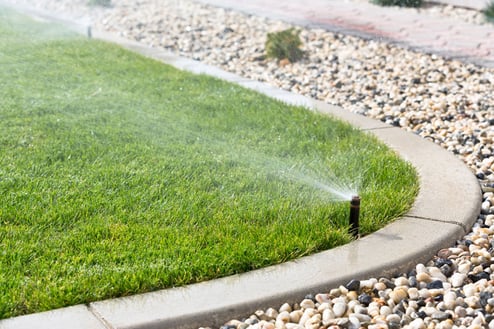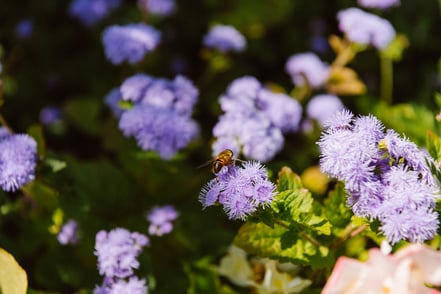Sustainability is about maintenance, but specifically, the maintenance of balance in our ecosystems and should be at the heart of everything landscapers do. In order to keep our planet healthy for future generations, we must find new ways of living without damaging the Earth.
So, landscaping and sustainability seem natural bedfellows, right?
Right. Landscaping is construction’s environmentally conscious companion. We can’t deny the need for residential and commercial development in a rapidly changing world, so let’s do our best to make this new world greener. On a small scale, a sustainable garden will benefit your local ecosystem with biodiversity and habitats for creepy crawlies, but on a greater scale, sustainable commercial landscaping can actively join the fight against climate change.
This is no small feat, and it’s understandable to be wary.
So why is sustainable landscaping so important?
Lately, sustainability, especially renewable energy, has gained a reputation for being costly, but this is short-sighted. Storing excess water to reuse for irrigation saves water costs, protecting your building from harsh weather reduces energy costs, and planting appropriate plants greatly reduces maintenance costs. While the costs of solar panels or wind turbines may be expensive initially, these expenses are quickly repaid when you use the renewable energy they produce. In any case, at the current rate of climate change, the environment must be the priority - and as more of us opt for more eco-friendly products, the market expands, and they become more affordable.
So let’s get into the details!
Water Management
Water conservation is absolutely crucial. Only 2.5% of the water on Earth is freshwater and making saltwater drinkable is expensive and energy-consuming. That’s why conserving water is also conserving energy.
Irrigation
 Automatic irrigation systems are of great benefit to the environment as they water according to the plant's needs and detect rainfall. Some irrigation systems also have their own water storage containers that collect excess rainwater ready for redistribution. Rain barrels also work well to collect excess water for reuse in the garden.
Automatic irrigation systems are of great benefit to the environment as they water according to the plant's needs and detect rainfall. Some irrigation systems also have their own water storage containers that collect excess rainwater ready for redistribution. Rain barrels also work well to collect excess water for reuse in the garden.
Rain gardens and swales are also an effective method of conserving water and preventing stormwater runoff, as they store water in a ditch-like reservoir that can water trees and other deep-rooted plants very efficiently.
But crucially, when designing your landscape, it's best practice to group plants according to their soil, sun, and water needs to reduce the cost of irrigation as well as minimize soil interference.
Energy Saving
Lighting
The first thing most of us think of when we hear “energy-saving” is light bulbs - and for good reason. Energy-saving light bulbs are very efficient in what they do and can greatly reduce your electricity bill. Some people may be put off by the dim light produced by some bulbs, however, this is in fact a benefit. Light pollution is a real problem in our cities and bright outside lighting is very confusing for nocturnal insects, so consider lowering light levels a win-win-win!
 Solar Panels
Solar Panels
Secondly, you can fully optimize your lighting by using solar panels. When expertly placed on roofs, photovoltaic systems, as they are also known, can collect a great amount of sunlight and convert it into energy either for your lights or other electric features of your landscape such as water fountains. In addition, solar panels can be turned into charging stations for other, bigger landscaping equipment. For example; battery-powered lawn mowers and hedge trimmers can be charged at solar charging stations, while some automated battery-powered weed pickers can even be controlled by smartphones. This new technology and electrically powered equipment are quieter than their fuel-powered counterparts and are emission-free. If your solar panel's electricity production exceeds your consumption, you can even sell it back to most governments.
Placement of Outdoor Features
Another effective way of reducing energy expenditure is by carefully placing trees and hardscaping features such as pergolas around your building. These large objects serve to protect your building from strong winds, heavy rain, and hot weather. Bushes and shrubs can be utilized to shade AC units to reduce energy usage and living green walls can even provide insulation against heat and sound as well as protect the building’s outer walls from harsh weather conditions.
Diversify Plant Life
There are many ways of selecting plants to make for a more sustainable landscape including xeriscaping, wildflower gardens, and promoting plant biodiversity.
Xeriscaping
Xeriscaping encompasses choosing a variety of native plants that are drought-resistant and slow-growing to reduce maintenance such as irrigation and fertilizer use. Native plants have evolved under the conditions set by the microclimate so naturally require less water, have some resistance to pests, and are at home in the original soil. This type of landscaping also renders large areas of grass unusable as they require such high maintenance, so it’s beneficial to cut back on lawns. The lack of maintenance also means less tilling of the soil which releases the carbon dioxide that has been stored underground. To add to its appeal, xeriscaping also reduces carbon emissions as native plants are more easily accessible in local areas, thus cutting down on transportation costs of more exotic and non-native plant types.
CO2 Absorbing Plants
While clearly, all plants benefit the planet by removing carbon dioxide from the air and replacing it with oxygen, there are particular plants that are most effective at this. Trees store a lot of carbon in their trunks and hedges sequester and store carbon in their branches, but some studies show that others can do a lot more.
Asplenium nidus, also known as bird’s nest fern, is proven to clean air of carbon dioxide very efficiently, especially indoors.
Crassula ovata, or Jade plant, is a kind of succulent that follows the photosynthetic process of CAM, meaning it stores CO2 as an acid at night so it can absorb it during the day and night. Other succulents and cacti are effective at carbon sequestration as they open their stomata at night, thus losing less water. They can also take airborne bacteria in from the air, cleaning it even further.
Bee Kind
 The additions of wildflower gardens, logs, and bamboo will provide a wonderful natural habitat for bees, butterflies, and other bugs when theirs is rapidly being removed. You can even integrate them into your living green walls to optimize their sustainability even further!
The additions of wildflower gardens, logs, and bamboo will provide a wonderful natural habitat for bees, butterflies, and other bugs when theirs is rapidly being removed. You can even integrate them into your living green walls to optimize their sustainability even further!
You’d be surprised how popular bugs and small mammals are in commercial landscapes. Rather than putting off visitors, they’re a great attraction for children and adults alike and can even be educational or interactive when combined with fun informative signs.
Hardscape Materials
The materials you use can have a great impact on the ecosystem too; so save yourself time and money, as well as the environment by recycling and reusing old materials!
Reduce, Reuse, Recycle
Wood waste can be easily converted to mulch for your soil, while plastics can be turned into edging or lumber. In addition, using locally sourced materials reduces pollution and energy consumption due to reduced transportation. However, be careful with some materials, like old railway ties, as they often contain creosote which can leak chemicals into your landscape and pollute nearby water.
Appearance
We understand concerns about the appearance of your landscape when using sustainable materials and upcycling, however, it doesn’t always mean a ‘shabby-chic’ look. Environmental concerns are not limited to any particular type of business and with the right designer, there is always a way of integrating sustainable materials and techniques into your landscape design. Having said that, compost areas are not always recommended for large commercial landscaping projects due to the amount of natural waste produced that may cause a less-than-ideal appearance or smell for your visitors. However, where possible organic materials being used as fertilizers are encouraged.
Permeable Paths
Your hardscape should also be permeable to prevent water runoff from overlogging drains, instead allowing the water to soak through and naturally water your deep-rooted plants or fill your swales. Pea gravel and river rock are fantastic alternatives to concrete and paved paths for the easy passage of water.
Karaoglu’s Sustainable Landscaping Commitment
Although local knowledge of the terrain will help, you don’t need to search for landscaping companies near me anymore. With climate change rapidly disrupting weather patterns and conditions, landscaping companies with the appropriate expertise and experience are perfectly suited to help design your dream sustainable landscape. At Karaoglu Landscape, we have three decades of experience in different microclimates and industries behind us and a commitment to employing sustainable working practices. Not only can we help you with your sustainable landscape design, but we can also help you maintain it. For more information, check out our website: www.karaoglu.com.tr/en
![karaoglu-web-footer[7].webp](https://blog.karaoglu.com.tr/hubfs/karaoglu-web-footer%5B7%5D.webp.png)
